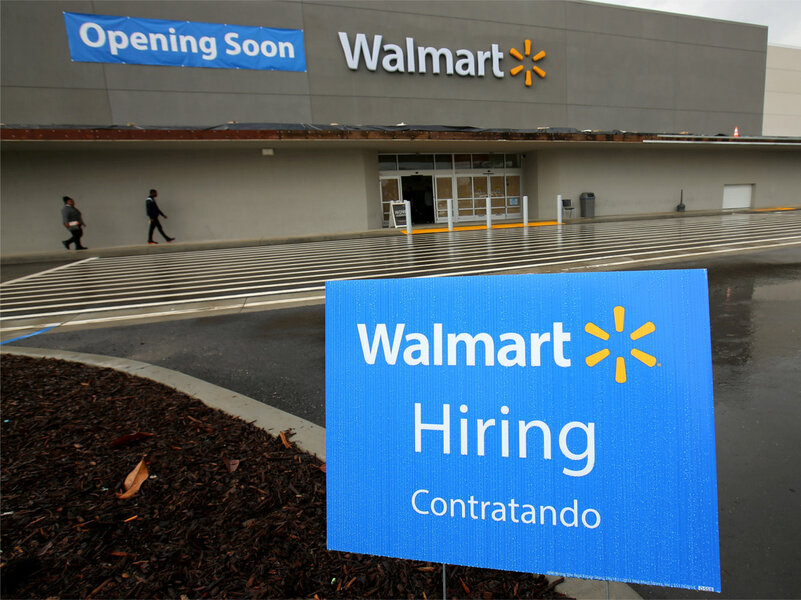What Wal-Mart's higher wages, better training mean for US retail
Loading...
On Tuesday, Wal-Mart announced plans to hire approximately 10,000 US employees in 2017. This comes on the heels of hourly wage hikes from from $9 per hour – the current starting wage – to $10.
But there's a catch: Employees will need to complete a six-month online training program called Pathways. The company is also building 200 “Academies,” where managers will need to attend hands-on training modules to be eligible for promotion. “When fully implemented, we expect to train about 225,000 people a year at these Academy facilities,” Scott Markley, a member of Wal-Mart’s Media Relations staff, tells The Christian Science Monitor in an email.
Wal-Mart is making a fundamental shift in its business model: from low-cost, no-frills retailing, to investing in its workers to take a more customer-service oriented approach. In effect, America's largest private employer (with 1.1 million hourly workers) is now borrowing a page from the small, local stores that have been threatened by the arrival of big-box stores.
Wal-Mart is also trying to stave off competition from e-commerce firms, including Amazon, that have shuttered hundreds of stores from retailers like Sears and Macy’s.
“They’re recognizing that the competition from the internet retailers like Amazon and so on can only be addressed by demonstrating that we’ve got really good customer service,” says Thomas Kochan, a professor at MIT’s Sloan School of Management.
In 2015, this approach – along with years of pressure from activists – coincided with Wal-Mart raising its starting salary to $9 per hour. The push for higher hourly wages is spreading across the US. In 2017, 19 states began the new year with higher minimum wages. Five states (Arizona, Arkansas, Colorado, Maine, and Washington) increased their rates through ballot initiatives, reports the National Conference of State Legislatures.
But when large corporations like Wal-Mart need to pay a higher wage, it increases their incentive to make other improvements – and reduce worker turnover.
Higher wages at Wal-Mart means that “now they have to recoup that in higher levels of productivity of their employees,” MIT’s Professor Kochan tells the Monitor in a phone interview. “That’s where the training should make a contribution.”
Kochan pointed out that other firms, including Costco and Trader Joe’s, have already strengthened training to improve customer service in the era of e-commerce. With the US’s largest retailer now focusing on productivity, other retail chains could follow suit.
But first Wal-Mart may need to gain acceptance from both workers and consumers. A 2011 Berkeley study found that the company could pay its workers $12 per hour, and only increase the cost of a typical shopping visit by 46 cents. In recent months, the company has coped with dwindling profit margins by cutting back at the corporate level, leaving both workers’ raises and customer savings intact.
Gaining acceptance from labor activists will likely prove more difficult. “This is a deep-seated anti-union company, and all of its managers get trained in trying to identify any forms of worker unrest or organizing,” Kochan explains. Leaked company manuals and PowerPoints dating back to 1991 suggest that Wal-Mart has trained store managers to prevent unionization.
Already, some labor unions see this as reason to dismiss the new "Academies," where Wal-Mart will send its managers for training. The United Food and Commercial Workers International union (UFCW) has organized – but not unionized – Wal-Mart employees through a campaign called Making Change at Wal-Mart. UFCW Local 1776 covers Pennsylvania’s Montgomery County, where one of the new Academies will be based. In a statement given to the Monitor, local president, Wendell W. Young, IV, argues:
“These Wal-Mart Training Academies are too little, too late. Wal-Mart is well-known for their mistreatment of workers. As a result, Wal-Mart has attempted to rebrand themselves over and over again. These academies are just another gimmick with no real-world benefits for the workers. Wal-Mart is merely attempting to divert attention from the fact that they pay employees paltry wages and provide little benefits, leaving taxpayers to pick up the bill.”
If Wal-Mart continues to train managers to prevent unionization, labor activists will have little reason to change their stance.
In addition, workers could see the anti-union policies as a sign of indifference, complicating the company’s larger push to improve customer service. As Kochan explains, “you can’t get there at the same time that you suppress worker voice … so tightly that workers are afraid to challenge management when they feel that their interests are at stake. So Wal-Mart has a long way to go, and it’s going to take a long time to change that culture."







